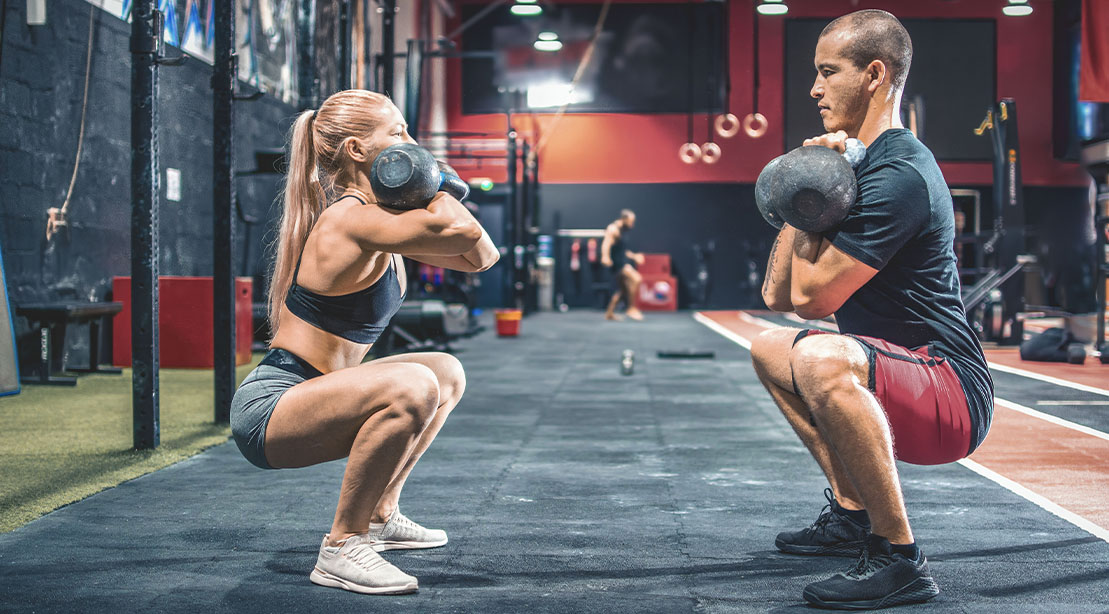5 Best Squat Variations for Strength and Size

The Top 5 Squat Variations
Belt Squat
If you have this in your gym, do not avoid it. The belt squat involves a special machine or setup that allows the lifter to squat while a belt attached to a weight source is worn around the waist. This setup removes spinal loading, allowing for squats without the traditional barbell on the back.
Why It’s Superior:
- Spinal Decompression: Reduces stress on the lower back while still allowing for heavy loading, making it suitable for individuals with back issues.
- Isolated Leg Development: Effectively targets the quads and glutes without compromising technique due to load on the spine.
- Increased Range of Motion: Allows for a deeper squat without the risk of losing stability.
Technique Considerations:
- Maintain a neutral spine and focus on driving through your heels.
- Ensure proper setup to avoid excessive forward lean; keep the torso upright.
Dual Kettlebell Goblet Squat
The dual kettlebell goblet squat involves holding a kettlebell in each hand at chest level while performing a squat. This variation emphasizes proper squat mechanics and core stability.
Why It’s Superior:
- Enhanced Stability: The positioning of the kettlebells requires greater core engagement, helping to stabilize the torso throughout the squat.
- Improved Mobility: This squat variation promotes better squat depth and mobility in the hips and ankles due to the upright torso position.
- Muscle Activation: It effectively targets the quadriceps, glutes, and hamstrings while also engaging the upper body for stability.
Technique Considerations:
- Keep your elbows tucked to maintain a strong grip and prevent leaning forward.
- Focus on pushing through your heels and keeping your chest up throughout the squat.
Axle Bar Zercher Squat with Heels Elevated
The Axle Bar Zercher Squat involves holding an axle bar (a thick barbell) in the crook of your elbows while performing a squat. Elevating the heels with plates or a wedge shifts the focus more onto the quads.
Why It’s Superior:
- Quad Emphasis: Elevating the heels increases the angle of the knees during the squat, placing greater emphasis on the quadriceps.
- Core and Upper Body Engagement: Holding the bar in the crook of your elbows challenges your core and upper body, enhancing overall stability and strength.
- Versatility: The Zercher position allows for a more upright torso, which can improve squat mechanics and reduce stress on the lower back.
Technique Considerations:
- Keep your elbows close to your body and maintain a firm grip on the bar to prevent it from slipping.
- Elevate your heels to the desired height and focus on driving through the midfoot and heels during the ascent.
- Ensure your chest remains up and your core engaged throughout the movement.
Barbell Box Squat
The box squat involves squatting down to a box or bench, which helps control depth and reinforces proper squat mechanics.
Why It’s Superior:
- Improved Squat Mechanics: By squatting to a box, lifters can focus on maintaining proper form, particularly at the bottom of the squat.
- Explosiveness: The pause at the bottom position, where you briefly sit on the box, allows you to generate explosive power on the ascent.
- Reduced Knee Stress: The box squat reduces forward knee travel and controls range of motion (ROM), which can alleviate pressure on the knees, making it a safer option for those with knee issues.
Technique Considerations:
- Pull the bar into the upper back, root your feet into the ground, and sit back into the squat as you descend.
- Keep your core braced and your chest up to avoid leaning forward.
- Avoid bouncing off the box—control the descent and ascent coming to a complete stop on the box while maintaining tension, then drive up explosively for maximum effectiveness.
Safety Bar Hatfield Squat
The Safety Bar Hatfield Squat is performed using a safety squat bar where it rests on your shoulders while holding on to the squat rack or other handles to help stabilize the load. This squat variation is named after powerlifter Fred Hatfield who popularized the technique.
Why It’s Superior:
- Enhanced Stability: The use of the hands on the rack or handles provides extra stability, allowing for greater control and focus on leg drive without compromising form.
- Increased Load Capacity: The added stability from the rack allows lifters to use heavier weights, making it ideal for building lower body strength.
- Improved ROM: Extra stability will allow for full body irradiation and tension allowing the body to move through deeper ranges of motion to improve quality movement and maximal muscle recruitment.
Technique Considerations:
- Keep your chest up and engage your core throughout the movement.
- Use the handles or rack for support but avoid pulling too much with your arms—let your legs do the work.
- Focus on driving through your full foot and maintaining a strong, upright posture.
By incorporating these squat variations into your routine, you can experience the benefits of improved strength, mobility, and overall performance. Remember to always focus on proper form and technique to get the most out of these exercises and reduce the risk of injury.
**Conclusion:** Squats are a cornerstone of strength training, and incorporating different variations can help you achieve a more well-rounded and effective workout. Whether you’re looking to build strength, improve mobility, or enhance performance, these squat variations are a great way to mix things up and take your training to the next level.
**FAQs:
- Q: What are the benefits of incorporating squat variations into my workout routine?
A: Squat variations can help improve strength, mobility, and overall performance by targeting specific muscle groups, fine-tuning squat mechanics, and reducing the risk of injury.
- Q: Which squat variation is best for me?
A: The best squat variation for you will depend on your fitness goals, current fitness level, and any injuries or limitations you may have. It’s a good idea to start with a variation that you’re comfortable with and gradually progress to more challenging ones.
- Q: How often should I incorporate squat variations into my workout routine?
A: It’s a good idea to incorporate squat variations 2-3 times per week, with at least one day of rest in between. This will allow your muscles to recover and adapt to the demands of the exercise.

